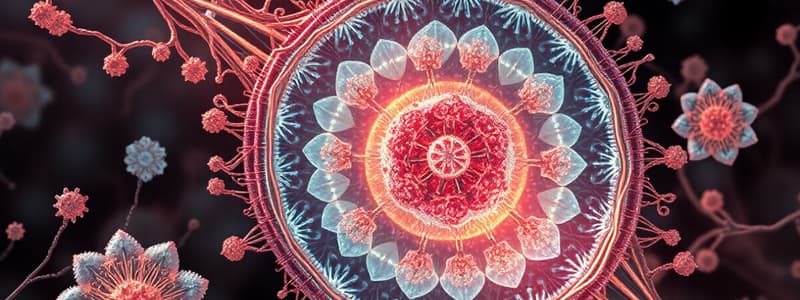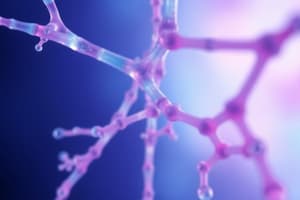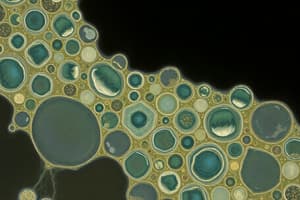Podcast
Questions and Answers
What did Anton van Leeuwenhoek contribute to the study of cells?
What did Anton van Leeuwenhoek contribute to the study of cells?
- He coined the term 'cell'.
- He proposed the cell theory.
- He was the first to observe living cells. (correct)
- He discovered photosynthesis.
Which scientist is known for disproving spontaneous generation?
Which scientist is known for disproving spontaneous generation?
- Theodor Schwann
- Matthias Schleiden
- Rudolf Virchow
- Louis Pasteur (correct)
What is the primary function of ribosomes in a cell?
What is the primary function of ribosomes in a cell?
- Protein synthesis (correct)
- Waste breakdown
- Photosynthesis
- Energy production
Which component of the cell is responsible for generating energy?
Which component of the cell is responsible for generating energy?
The cell wall is primarily found in which type of cells?
The cell wall is primarily found in which type of cells?
What role does the nucleolus play within the cell?
What role does the nucleolus play within the cell?
Which part of the plant cell is responsible for carrying out photosynthesis?
Which part of the plant cell is responsible for carrying out photosynthesis?
The jelly-like substance that fills the inside of a cell is known as what?
The jelly-like substance that fills the inside of a cell is known as what?
Flashcards are hidden until you start studying
Study Notes
Cell Discovery and Theory
- The term "cell" was coined by Robert Hooke, inspired by the resemblance of cell compartments to monks' small rooms.
- Anton van Leeuwenhoek improved the microscope and was the first to observe living cells, including bacteria, red blood cells, and sperm.
- Louis Pasteur disproved spontaneous generation and introduced pasteurization to eliminate harmful bacteria in food.
- Matthias Schleiden proposed that all plants consist of cells, establishing a key principle in cell theory.
- Theodor Schwann extended Schleiden's theory to animals, asserting that all living organisms are composed of cells.
- Rudolf Virchow stated that all cells arise from pre-existing cells, reinforcing the foundation of cell theory.
Cell Structure and Components
- Cytoplasm is a jelly-like substance that fills cells, housing organelles and other components.
- Ribosomes are small organelles essential for protein synthesis.
- The cell membrane is a flexible barrier surrounding the cell, controlling the passage of substances in and out.
- The cell wall, found in plant cells, is a rigid outer layer that provides structure and protection.
Key Organelles and Their Functions
- The nucleus is the cell's control center, containing genetic material (DNA).
- Lysosomes contain enzymes for breaking down waste and cellular debris.
- Mitochondria are known as the powerhouses of the cell, generating ATP through cellular respiration.
- The endoplasmic reticulum (ER) is a network of membranes involved in protein synthesis, lipid creation, and detoxification.
- Vacuoles are large sacs that store water, nutrients, and waste products.
Specialized Organelles in Plant Cells
- Chloroplasts are organelles where photosynthesis occurs, converting light energy to chemical energy.
- The nucleolus, located within the nucleus, is where ribosome assembly occurs.
- Chlorophyll, the green pigment in plants, captures light energy for photosynthesis.
- Leucoplasts are colorless plastids responsible for starch storage.
- Thylakoids are flattened sacs within chloroplasts that house chlorophyll.
Other Important Cell Structures
- Stomata are pores on leaf surfaces that facilitate gas exchange.
- The cytoskeleton is a protein filament network providing structural support and aiding in cellular movement.
Studying That Suits You
Use AI to generate personalized quizzes and flashcards to suit your learning preferences.




